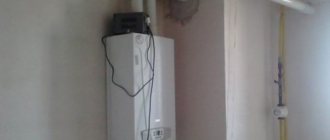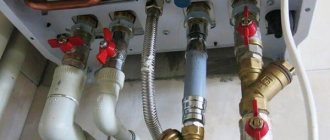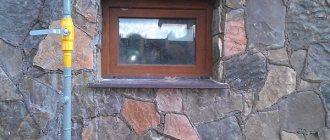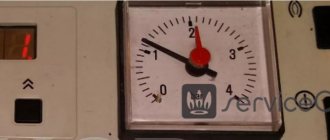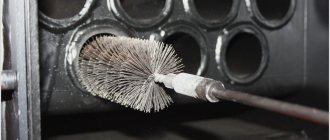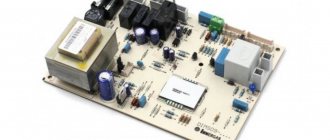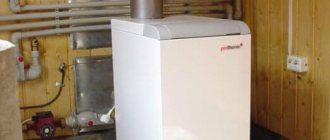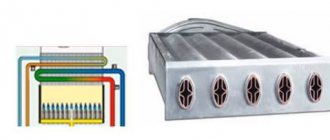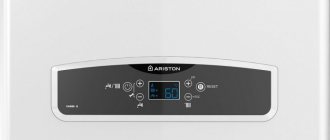Today, purchasing a boiler is not difficult. Of course, if you have the funds to purchase. The range of heating products on the market is very wide. But what if you don’t have enough money and you can’t do without a boiler?
Homemade electric boiler
The solution has long been found and is widely used - weld a heating boiler with your own hands. How to do this correctly so that the heater works no worse than the factory one will be discussed in the article.
Types of heating boilers
Before you begin, decide what type of boiler is required. Correctly assess the possibilities of supplying this or that fuel in your region, find out its cost.
There are several types of heaters depending on the fuel used. You can do any of them yourself:
- Electric is the simplest. It is a tank or pipe with a built-in heating element. Two pipes are connected to the tank, connecting the boiler with the supply and return lines. The design is simple; no chimney or combustion chamber is required.
But keep in mind that electricity is an expensive fuel, and during voltage drops, which are typical for power grids in Russia, the boiler operates intermittently, power and water temperature drop.
- Gas. Its design is more complex. When constructing, keep in mind that installation will require permission from the gas service. A self-made boiler may not be accepted for use.
- Liquid fuel. If you have cheap diesel fuel, that’s a good solution. But you will have to look for a room for a fuel warehouse with the appropriate safety requirements and build an insulated fuel pipeline. Setting up the burner of such a boiler is a complex procedure.
- Solid fuel. The optimal type of boiler for home-made production. Simple, reliable, and firewood is available everywhere. Such units, made by home craftsmen, are installed in houses and cottages throughout the country. This is what we will talk about today.
Solid fuel boiler
Corrosion
Due to the constant circulation of water, weak points may be susceptible to corrosion. Anti-corrosion compounds are used in the manufacture of boilers. But they are not used in the production of boilers. Heating boilers are made of cast iron or steel, and they are subject to corrosion. But boilers can work longer than their service life. Heating boilers are resistant to corrosion, as they have walls 1.5 mm thick, and the walls of the combustion chamber are more than 2 mm thick. Therefore, such equipment works efficiently throughout its service life. But sometimes minor breakdowns occur. And if the boiler is leaking, then it is necessary to fix the problem, if possible, or replace the device.
What you need
To assemble a heating boiler yourself, you must have welding skills. Moreover, good qualifications. Poor quality seams will lead to boiler failure or an accident - gas poisoning.
To work you will need the following tool:
- Electric welding machine;
- Gas cutter;
- Bulgarian;
- Hammer;
- Roulette;
- Marker or chalk.
The following materials will be required:
- Seamless steel pipe with a diameter of 42.5 cm and a wall thickness of 6 mm;
- Pipe with a diameter of 10 cm;
- Pipe with a diameter of 2.5 cm;
- Sheet steel with a thickness of at least 4 mm;
- Squeegee with a diameter of 2.5 cm - 2 pieces;
- The loops are small;
- Corner 2.5 cm;
- Fittings with a diameter of 8 mm.
Gas boilers for heating systems of a private home
Our online store offers a wide selection of gas boilers for heating systems, but in order to choose the right equipment, taking into account all factors, we definitely recommend contacting our specialists for help. And this can be done not only by phone, by calling one of the company’s branches, but also directly on the website of the online store, using the feedback service.
In the event that repair or maintenance of boiler equipment is required, you can always get qualified assistance from our highly qualified craftsmen. If necessary, they will conduct testing and issue a verdict with a recommendation on what is best to do: choose a new boiler or repair the old one. If the question of replacement nevertheless arises, then it will not be difficult to make a choice in our online store, since we have a wide selection of single-circuit and double-circuit models of different capacities from leading manufacturers. All of them are distinguished by modern design, ease of use, high efficiency and the presence of protection systems, which will ensure their safe operation throughout their entire service life. Goods purchased from the Alfatep online store can be delivered by our transport service to the address specified in the application, and our specialists are ready to undertake the installation and commissioning of equipment.
Construction and design
Drawings and designs of boilers are available on the Internet. There are many design options, but all are based on the same principle - burning wood (coal or pellets) in a firebox and heating water in a heat exchanger or container above the firebox, followed by circulation through the heating circuit.
Water in this design is heated from all elements, including a chimney passing through a water tank. The boiler body also heats up and releases heat to the water after the combustion process in the furnace is completed. Hot water rises, exits through the upper pipe and rushes through the pipes of the heating system. Having passed through the heating circuit, it returns through the lower pipe (return) to the boiler cooled, and the process is repeated again.
- The first step is to build the boiler body. To do this, take a thick pipe (42.2 cm) and cut a piece one meter long. To do this you will have to use a gas cutter. The edges need to be processed with a grinder.
Sample boiler design
- Then the slots are made for the firebox and the blower. They are rectangular and are located above each other (the firebox above the ash pan) at a distance of 5 cm. A cutout with dimensions of 20 by 10 cm is required for the firebox, and 20 by 3 cm for the ash vent. 5-7 cm is left from the bottom edge of the pipe to the ash vent. Cut off Don’t throw away the parts - they will make doors.
- After this, holes are made for the supply and return pipes. It is recommended to make holes with a diameter of 25 mm, they are placed on the same line. In this case, the return supply is carried out above the firebox 15 cm above the top edge. The water supply pipe is cut 5 cm from the top edge of the pipe (body). Next, the bends are welded to the holes.
- Now we begin to create the internal parts of the boiler. First, you need to cut three pancakes from a steel sheet. Two with a diameter larger than the body - 42.5 cm and one with a smaller diameter - 41.2 cm. It must then be installed inside. Taking into account the thickness of the pipe walls, a difference in diameter of 1 mm will ensure ease of entry into the pipe.
- After this, a hole with a diameter of 10 cm is cut out in the center in one large and small pancake. This is required for inserting the chimney. The chimney itself is cut from a prepared pipe with a diameter of 10 cm.
- The legs for the boiler are made from a tube with a diameter of 2.5 cm. For this, four pieces 5 cm long are used. The ash pan is made from fittings, which are welded from pieces of a length suitable for the diameter of the boiler body.
Hot water boiler
How to weld a heating register with your own hands
Types of registers
How to properly weld a heating register and in what cases is it recommended to install them? First you need to correctly understand their purpose. In essence, these are heating devices that must ensure maximum heat transfer from the hot water of the heating system to the room.
Before welding the heating registers, it is necessary to prepare the basic material for manufacturing:
- Main pipes. They should be relatively large in diameter - up to 100 mm. For forced systems with high temperature conditions, it is recommended to use just these. It is better that the pipe cross-section is round, since profile structures will create high hydraulic resistance, which is undesirable;
- In order to properly weld the heating register, you will need pipes of a smaller diameter, which will serve as pipes for coolant circulation between the main horizontal ones. Their cross section should be in the range of 24-30 mm.
At the first stage of work, you need to cut all the pipes according to the previously prepared drawing. Then, before welding the heating registers, it is necessary to make plugs for the ends of large pipes. They are divided into two types - blind and with inlet pipes. With the help of the latter, the coolant will move along the register contour.
The order of the work is as follows.
- In order to properly weld the register of the heating system, you must first cut all the pipes according to the drawing. For this purpose, a “grinder” is used. At the end of the work, the end parts are cleaned;
- Production of plugs. For them you need to use metal of the same thickness as the pipes. The diameter of the plugs must be larger than the cross-section of the pipe by the thickness of the metal. This is necessary for welding the fastening edging. After their manufacture, installation is carried out using the welding method;
- Before welding the heating system registers using adapter pipes, it is necessary to make holes in the pipes. It is best to do this with a welding machine, since it is impossible to cut a round hole with a grinder.
The final stage of work is connecting large pipes into a single heating device - a register.
Assembly of the unit
Assembling the boiler begins with welding the chimney to a small-diameter pancake (41.2 cm). Then temporary stops are welded inside the body at a height of 30 cm from the edge of the firebox. For this, ordinary steel wire or the same reinforcement is used. Then a pancake with a chimney is placed on top of them.
After this, the most difficult and responsible part of the work begins - welding the pancake to the body, on both sides. The pancake serves as a boundary or wall between the firebox and the water tank, and everything depends on the quality of this seam.
Then a pancake with a diameter of 42.5 cm with a hole is placed on top of the chimney and all the seams are thoroughly welded - between the chimney and the pancake and between the pancake and the body.
The next stage of work is the installation of the ash pan. First, a grid of reinforcement is inserted inside the body on the other side, and then stops from the corner are welded, onto which the ash pan will lie when the pipe (body) is turned over. The ash pan is installed between the firebox and the ash pan.
After this, the remaining whole pancake is welded to the lower edge of the pipe (body) and the legs of the boiler are attached to it. Next, all that remains is to make the doors. Hinges are welded to the edge of the firebox and pieces from the cutouts and the door is hung.
The blower valve can be made in different ways. It can be just a regular door, in the form of a gate or a rotary valve with holes in the body.
There is another option - buy ready-made doors, latches or dampers. They are made of cast iron and equipped with thermal insulation, eliminating the likelihood of severe burns upon contact.
Blower doors and valve
High blood pressure
If the pressure in the system exceeds the design pressure, the heating boiler may leak. Each boiler is designed for a certain pressure value. If overheating occurs and the pressure rises, the volume of water will increase. As a result, the solder will crack and the boiler will leak. This will happen if there is no emergency valve. If it is installed, then you can avoid such an unpleasant situation.
The emergency valve and pressure gauge should be checked periodically. They may be faulty. Then you will not be able to prevent an accident. It happens that the valve begins to jam. In this case, you need to unscrew it and then soak it in citric acid. Afterwards you can screw it back in and check its operation.
It is recommended to drain the water and check the membrane tank once a year.
If the maximum pressure in the heating system is 1.5 atmospheres, then the air pressure in the membrane tank will be sufficient 1 atmosphere.
Many people believe that in an open heating system where the expansion tank is located, there is no pressure. But this is not true. There is pressure in any heating system. Although in a closed system any pressure can be applied. But it is also present in an open heating system. It can be assumed that a boiler, which is designed for a pressure of 1.5 atmospheres, can be used in a building that has 4 floors.
Connection and testing
When the boiler is ready, it is necessary to test the tightness of the seams. For this purpose, a plug is screwed onto one of the outlets, and water is poured into the second. If it doesn’t leak anywhere, you can be sure that the boiler won’t leak during actual operation either.
The video shows the manufacturing process of a pyrolysis boiler:
Now the boiler needs to be connected to the heating system. For this, established drives are used. Pay special attention to the installation of the chimney. Make sure it goes straight up. If it is not possible to install it in this way, then no more than three taps are allowed. In the attic area, it is recommended to insulate the chimney.
When everything is ready, you can start the test fire. It is not recommended to use a large amount of fuel for the first time. The most important thing now is to heat the boiler and chimney. During the testing process, the gap in the blower is adjusted and the optimal one is determined experimentally.
During operation of such a stove, it is important not to exceed the height of the stack. There must be at least 20 cm between the top edge of the fuel and the water tank. This ensures complete combustion and normal removal of carbon monoxide.
Dead water
“Dead water” must circulate in any heating system.
There is no rust or other growths in copper heating pipes. Therefore, there is no need to examine the insides of the pipes. It is better not to use galvanized elements in the heating system, as they quickly rust.
Due to dead water, air is removed from the system, so the water circulates without oxygen. Since there is no oxygen in the system, boilers and radiators made of steel do not rust. We can conclude that “dead water” is necessary in the heating system. If it is necessary to add water to the system, then you need to urgently look for the cause of the pressure drop. If it is not eliminated, the steel radiators and boiler will suffer. It is not recommended to drain water from the heating system unless necessary.
In an open heating system, it is necessary to leave a small hole on the cap of the expansion tank to release air. If a large hole is made, oxygen will flow into the tank. It would be better to arrange a closed heating system.
